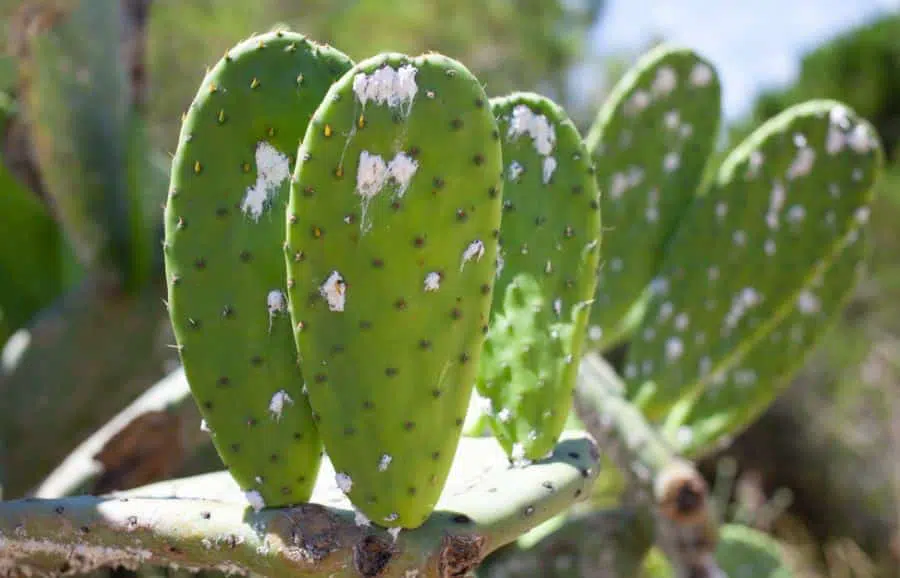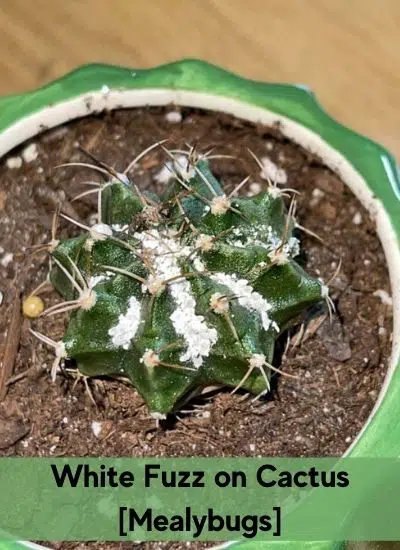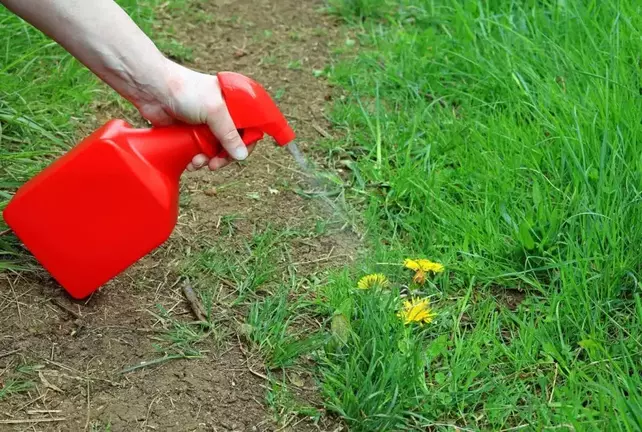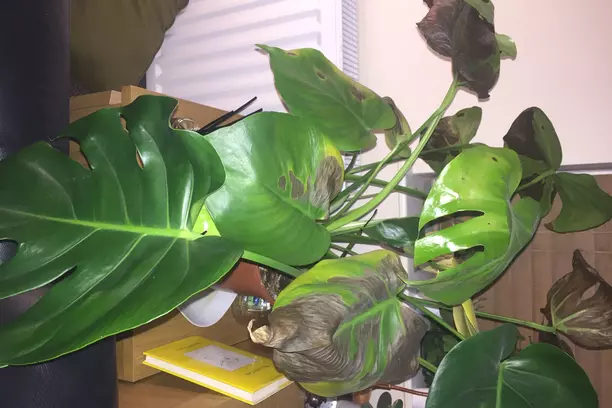The presence of white fuzz on cacti can diminish their aesthetic appeal and affect their growth. So, what causes the white fuzz on cactus, and how do you get rid of mealybugs on cactus plants?
Mix rubbing alcohol with water in a ratio of 1:3 and pour it into a garden spray bottle. Spray all the cacti that are infested with white fuzz to kill the pests. Alternatively, introduce ladybugs to your cacti to prey on the mealybugs and get rid of the white fuzz on your cacti plants.
I’ve used the Bazos ladybugs on my plants and they are great at controlling mealybugs and other destructive pests such as aphids naturally. If you don’t want to apply a pesticide on your indoor plants and outdoor gardens, you’ll find them useful.
What’s the white fuzz on the cactus?

The pests that cause the white fuzz are called mealybugs. If you spot white fuzz on your cactus plants, you’re most probably dealing with a pest infestation.
As the population of these bugs grows on your cacti, they gather and group together. Since they have cotton-like wax surrounding their bodies, this clumping together appears like white fuzz.
Adult mealybug females lay eggs and produce an ovisac to cover them. To the naked human eye, the combination of the cotton-like ovisac and mealy wax secretion looks like tiny spots of cotton.
To confirm that the white fuzz is indeed a group of mealybugs and not plant pests like aphids, take a closer look at the plants using a magnifying lens. There are over 250 mealybug species but they share some common characteristics.
- Mealybugs have an oval body shape
- They are tiny in size, measuring between 0.05- 0.2 inches.
- Mealybugs can be pink and grey in color
RELATED: HOW TO USE NATURAL VINEGAR SPRAY FOR APHIDS
The most common mealybug species that invade garden plants is the citrus mealybug. Meanwhile, the long-tailed mealybug has a long tail filament, making it relatively longer at about 0.25 inches in length.
Mealybug damage on cacti
Mealybugs can’t fly but have well-developed legs for mobility. They suck on the sap from the soft plant tissue, such as succulent cactus paddles. These pests are more likely to invade cacti growing indoors, as they prefer interior plantscapes. However, don’t be surprised if you spot them in your outdoor garden as well.
Stunted growth
As they suck moisture and nutrients from your cactus plant tissue, your cacti become weak, leading to loss of color, coupled with stunted growth and development.
Even worse- with fewer nutrients- they become even more vulnerable to diseases. If you’re growing orchid cactus, the mealybugs will wipe out the plant’s beautiful flowers.
Moldy stems and leaves
As mealybugs feed, they also excrete a sticky substance called honeydew on the cactus plants. This excrement attracts fungal infestation in the form of mold spores.
As the black-colored sooty mold covers your cacti, they not only diminish the aesthetic appeal of the plants but also undermine the photosynthesis process by preventing more sunlight from reaching the green plant parts.
Insufficient photosynthesis can result in the overall decline of the plant’s life.
How to get rid of mealybugs on cactus

There are several methods for controlling mealybug infestations. However, the best solution may depend on whether you’re growing your cacti indoors or outdoors.
Here’s how to get rid of mealybugs on cactus:
- Create a spraying solution by mixing rubbing alcohol with water in a ratio of 1:3.
- Pour the solution into a spraying bottle and test it on a small, single part of the cactus plants.
- If no damage occurs, spray all parts of your cactus plants to kill the mealybugs.
- Repeat this procedure weekly until you get rid of all the mealybugs if the infestation is severe.
Note: Never spray rubbing alcohol directly on your succulents, as it may cause damage to the cactus plants. Testing the treatment is important because even the diluted solution may still be strong enough to burn your succulents.
After spraying the plant, you’ll notice the mealybugs turning brown; it means that they’re dead.
Alternative natural ways to kill mealybugs
If you don’t have any rubbing oil, a good alternative for killing mealybugs on cacti would be neem oil. This natural insecticide will kill all mealybugs on contact. However- just like rubbing alcohol- neem oil shouldn’t be used in its concentrated form.
Neem oil + dish soap
To avoid burning your cactus plant parts, mix neem oil with water and dish soap. You can then transfer the solution and spray the cactus plants. After spraying with the solution, finish the process by rinsing the cacti with clean water to wash the mealybugs off the plant parts.
Remember, rubbing alcohol and neem oil solutions are best reserved for indoor plants. Applying them to cactus plants growing outdoors may result in sunburn. Therefore- to kill mealybugs growing on outdoor cacti without damaging the plants, we recommend a natural remedy- ladybugs.
Ladybugs (natural predators)
Cryptolaemus montrouzieri is a ladybug species that are commercially available as a mealybug-killer. The best time to introduce them to your outdoor cactus garden is in spring and fall.
Before unleashing them on your plants at dusk, ensure you sufficiently water your cactus paddles. Being that the ladybugs are usually confined before being released, they’ll continually perch on the wet cactus paddles, feeding on mealybugs in the process.
Natural mealybug control using ladybugs has its limitations and is best used during the earlier stages of infestation. If you’ve tried this solution multiple times but can still spot mealybugs on your outdoor cacti, it means that you’re dealing with a severe infestation.
For such larger mealybug populations, you need a stronger solution to completely eradicate these pests. For such instances, you can use a mild chemical insecticide that won’t burn the succulents.
Preventing Mealybugs on Cactus
Instead of waiting for mealybugs to invade your cactus plants and deal with the issue then, why not take proactive control measures? These controls can prevent these pests from invading your landscapes in the first place. Here are some effective preventive measures to help keep mealybugs away from your cactus plants:
Avoid overwatering
When you overwater your cacti, the succulent paddles hold excess water, making them more attractive to pests like mealybugs and aphids. The recommended irrigation frequency for most species of cacti is once per week.
RELATED: HOW OFTEN YOU SHOULD WATER YOUR CACTUS PLANTS
Clean up the environment
Note that apart from perching onto the paddles and buds of your cactus [plants, mealybugs also like to lurk in the surrounding environment. For instance, they may be hiding in the pots in which the cacti are planted, or even inside the mulch in your garden. What’s more, mealybug eggs may also be present in the soil.
Therefore, to prevent re-infestation after eradicating mealybugs, clean up the pots and repot with a succulent-ready soil mix that hasn’t gone bad.
For cacti growing outdoors, remove the old mulching and replace it with new mulch. Finally, you can kill mealybug eggs present in the soil by baking the soil in an oven at high temperatures.
RELATED: HOW LONG DOES IT LAST FOR POTTING SOIL TO BECOME BAD AND EXPIRE
References:
[1] Steven Frank, Associate Professor Entomology, NC State Extension: Mealybugs control in plants
[2] University of California, Agriculture and Natural Resources, Statewide Integrated Pest Management Program: Managing pests in gardens – Mealybugs



